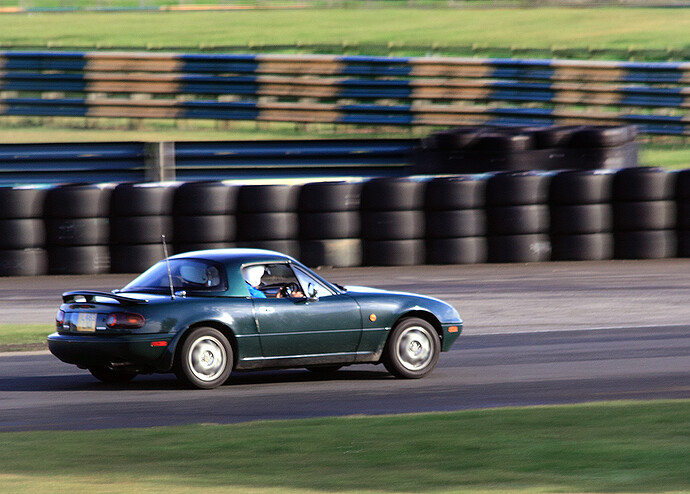Yes, lots of avenues lead to the same result.
i think this thread is 70% criticising the OPs comments or undercarriage (oioi). Its still on topic!
I dont think DirtHabit noticed though, or theyve just ignored it. dont worry. ![]()
but i think the issue is found now. From more looking around online across other forums and some of th youtube reviews, i am not unique in this view. i think its simply a difference between those who use the ND as a casual car or GT car, vs those of us who push it harder. those who push it harder seem to be having similar comments: ‘twitchy rear end, unpredictable’ etc at high speeds. Crucially, not at low speeds. hence most drivers at their limits and driving style will never experience this ‘issue’. which as ive mentioned above, is Lift.
In fact after a recommendation from another forum i have now proven it is indeed lift (negative downforce) at the rear.
Theres some corners here (friends road) which i can repeatedly take at 70mph, and its quite tight and at that speed the back end is kicking out with steadly throttle. 68mph is its limit by which i mean ‘limit’ = ‘i dont need to intervene’.
I grabbed some gym weights and a bag of tarmac (i had lying around) which added 60kg into the boot. the same corner i now did not have to intervene until 73mph. a huge improvement.
if this was a tyre grip limit @ 0 lift or positive downforce, then this would not have worked, as the tyres would already have been at limit in this scenario. by adding this weight i am directly countering the lift being generated by a fixed amount.
So - my next focus now will be to get the car in the air and start looking at sorting a flat underbody. if youv been under your mx5 then you may have noticed too that its very… umm… 90’s ![]() most modern cars now, even regular family wagons, have a flatter underside than this mx5.
most modern cars now, even regular family wagons, have a flatter underside than this mx5.
Going up to my previous comment, i think that OEM backbox removal may be a primary negative factor. its opened a huge void in the rear bumper.
Fascinating stuff.
I think the lack of undertrays was probably part of the gram strategy, but it’s interesting that there’s not more discussion about it online. Bofi seem to have some filler panels for the underside, which might combine well with a rear diffuser?
I love the real world physics experiments with ballast! Maybe that 100kg saved from NC to ND was a bad move!
However, I am not sure I understand this bit.
By adding 60 kg, haven’t you have increased the friction at the rear tyres, so effectively increased the grip limit?
the experiment
there are online posts about it which will explain it better.
this snippet i think is a great couple of lines on it, without being technical:
''Lift and Reduced Grip: Lift reduces the effective load on the tires, which in turn reduces their available traction. When the tires are at their traction limit, this lift effect limits the maximum lateral force they can generate, reducing cornering capability.
Adding Weight Counteracts Lift: By adding weight, you effectively counteract some of the lift, increasing the normal force on the tires. This increase in normal force allows the tires to generate more lateral grip, even though the car itself is heavier.
So, with the additional weight offsetting the lift, the car would regain some lost grip, which should indeed allow for higher cornering speeds. However, it’s important to note that this approach is typically less optimal than reducing lift or generating downforce, as added weight also affects acceleration and fuel efficiency.
‘’
To add my little spin on it which helps me make sense of it (*but bear in mind, this is just example numbers to explain. it doesnt cover all sorts of variables and real numbers!):
if a car weights 1000 KG, then its theoretical max lateral grip/force is 1G (1x force of gravity). So the max grip the tyres can sustain laterally(sideways) is also approx 1000KG.
If the car weights 1200KG, then the lateral 1G is 1200kg. etc.
What this tells us, is that adding more weight does not increase grip (in terms of friction).
If the car has lift, then if the car if under lift forces of 100kg, then the max lateral grip reduces to 900kg. (0.9G) meaning poorer cornering speeds.
This amplifies massively with forward speed (air speed). as if im correct its 2x the speed = 4x the aerodynamic effects. so the difference between 50mph and 10mph is 4x more/less Lift.
Where does the ballast experiment come in based on this?
so by adding 60kg to the back (where i expected the lift issue to be) i am making zero difference to lateral traction at low speeds. but if i am generating 60kg of lift at say 60mph, then i have in effect negated some (all?) of this. not by increasing tyre grip, but by restoring some tyre grip to bring it closer to the 1G grip capability.
i hope that helps?
i havent mentioned downforce at all. on purpose. but using the same examples if i remove/negate that lift then the ballast wont be required or will have little effect on cornering, and will be more of a detriment/concern due to fuel ecomony, weight transfer, car front/rear balance etc. lots of things to think about!
If you do have downforce (not lift) then you start to get into the realms of 1.1G+ laterally.
this was just a specific experiment to determine - ‘‘am i suffering rear end lift?’’, to which the answer i am quite sure is ‘yes’.
Looking forward to hearing how you get on. I’m not driving that quickly on the roads round here, but can see the appeal of more downforce with more discretion than a big wing when doing the occasional track day.
I want you to think about these 2 statements very carefully.
These calculations mean nothing without considering the road contact surface area and grip coefficient (am I using that term correctly?) of your tyres.
Just like every other car in existence when the brakes are applied. There is a reason for driving methods such as “brake before, throttle through, power out”. This also means that the ballast you’ve added is contributing towards the handling imbalance, especially when lowering speed, and is adding towards the lateral force in high speed cornering. You are better off focussing on suspension functionality and unsprung weight than playing around with marginal amounts of ballast.
No, the grip limit is determined solely by your tyres. You’ve increased the friction to the contact area, but not increased its overall grip capability. Surface area of contact, grip of the tyre compound, stiffness of the tyres etc etc. Stiffness of the suspension also comes into play, and in lighter cars like these unsprung weight ratio is also a big consideration (that’s probably the only benefit of the ballast). Ballast is mostly a consideration for straight line traction, which is not an issue in an mx5.
Stiffer suspension is only for cars generating considerable amounts of downforce. This is a basic consideration that 99% of people modifying cars do not make. Maybe stiffer suspension can feel better on a nice, smooth track because you feel less body roll, but on most public roads, with their uneven surfaces and neutral or unoptimised camber, you are pretty much reducing your overall grip. Also, without some form of active suspension system, the anti-roll linkage must be considered. Stiffening suspension = less travel = less anti-roll linkage actuation. So, although it feels better for you to not be swaying about in the passenger compartment, you’re actually putting more weight and lateral force into the outside wheels during cornering, especially in a low downforce car, thus reducing your traction.
I want you to think about these 2 statements very carefully.
I want you to think about the context of these quotes very carefully.
again context.
who has mentioned braking??
I can see you don’t want to consider my points, so let’s just leave it there. There’s a reason why good braking INCREASES your lap times. The fact that you are excluding braking/decelerating as a contextual factor in handling shows what sort of mechanic and driver you are.
“I am driving around a tight corner at 70mph in a car I haven’t had long and the back end is unpredictable”
This is you.
I mean, in all honesty, the solution is incredibly simple for the “problems” you are describing: Get a spoiler.
Much nicer to be able to sort it out without resorting to an unsightly wing on the back of the car. I really like the idea of using the underside of the car to the same effect. Not cheap to do properly though.
Aye, but the principle is the same: This is an aero issue. A road car is designed to be a road car, whether or not it is in the “sports” category. The wheel and suspension alignment (also worth looking at in more depth, imo) issues were sorted with the bushings (remember the bit about not being able to control the car in a straight line?), producing a more predictable drive. Stiffer suspension was fitted, which now demands more downforce to be an effective modification, so it becomes an aero issue.
Apart from more passive downforce, the other glaring solution would be to fit wider wheels and tyres. Increasing the negative camber of the rear wheels could also help in cornering stability, although this would affect the stright-line stability.
Guys:
Public service announcemt.
Just get a rot free ( restored) Mk1. The rattles, pops 'n bangs will take you mind off everything else, and you will be delighted it actually brought you back home. Like they always do.
I should know.

Flat floors often come with unintended heat retention issues.
Took my newly acquired 2019 RF on a 1200 mile round trip to Speyside recently and took the A96 Old Military Road over Glenshee in some of the worst weather I’ve driven anything in. Car was rock solid and handled brilliantly only getting a bit tail happy at one point, where a “river” was crossing the road!
Found it comfortable on the first 6 hour leg to Glasgow, for overnight stop, contrary to some comments I have read elsewhere about the cramped cockpit etc, but my ‘glass’ back was fine when I got out!
Not only that but I would think you would have to be very careful about aerodynamic issues. A flat smooth underside without the necessary additional ground effect surfaces such as used on the (Lotus 72 I think) could mean that you end up with an aerofoil section i.e. the air has to travel further over the upper surfaces of the car than underside which could actually create lift in some circumstances. The way around this would be to have a very large and effective rear diffuser that which creates a longer path for the laminar air flow underneath the body in effect creating an upside down aerofoil. The rear “Spoiler” on some models of the MX-5 disrupts (turbulates) the air going over the body also may help in disrupting this aerofoil effect in this respect but is mainly there to reduce drag. It is not the same as the inverted rear wings fitted to some cars including F1 and rally cars.

